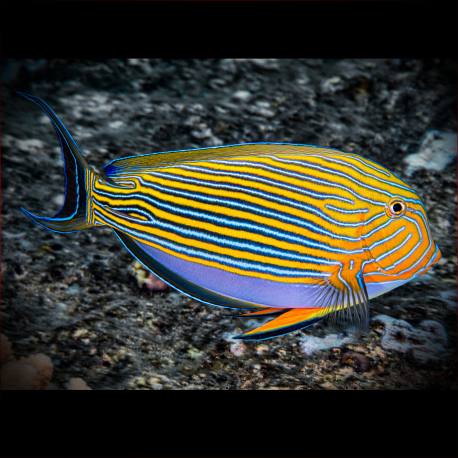More info
Datasheet
| Minimum Tank Size | 1000 litres / 264.17 US gallons |
| Maximum Size | 38cm / 14.96inches |
| Reef Compatible | Always reef safe |
| Temperament | Aggressive towards similar species |
| Temperature | 22.2°C / 71.96°F - 25.6°C / 78.08°F |
| Specific Gravity | 1.020-1.025 |
| Carbonate Hardness | 8-12 |
| pH | 8.1-8.4 |
General Description
The Clown Tang, scientifically known as Acanthurus lineatus, is a member of the Acanthuridae family, commonly referred to as Surgeonfish. These fish are known for mimicking different Angelfish species as juveniles to avoid predation, making them challenging to distinguish at a young age. With their striped appearance, they can grow up to 38cm in size and reside in the Indo-Pacific region, ranging from East Africa to Japan and down to Australia and New Caledonia.
Aquarium Suitability
Considered suitable with care for aquariums, Clown Tangs have high demands in terms of tank size, water quality, and surroundings. They are aggressive towards similar species, requiring careful consideration when selecting tank mates. It is crucial to provide regular feeding, ample hiding spots, and sufficient space to mitigate potential aggressive behavior.
Demands, Care, and Hardiness
Clown Tangs are delicate in terms of hardiness, requiring a high standard of water quality, especially in terms of proper oxygenation. They are algae eaters that primarily rely on a diet of small crustaceans like krill, mysis, and artemia. These fish thrive in well-established aquariums with abundant algae growth, necessitating a balanced diet of macroalgae like seaweed/nori and microalgae such as spirulina.
Reef Suitability
Known as reef-safe inhabitants, Clown Tangs do not typically pose a threat to corals or invertebrates in a reef environment. However, caution is advised with large Palettes/Blue tangs, as they may display some exception to this behavior.
Aquarium Setup
When setting up an aquarium for Clown Tangs, it is vital to include plenty of hiding places, especially when introducing them to a new environment. These fish require a spacious tank of at least 1000 liters to accommodate their swimming habits. Providing a well-established tank with ample algae growth on rocks and stones is essential for their grazing behavior.
Behaviour
In an aquarium setting, Clown Tangs spend most of their time swimming around and nibbling on algae. They establish a hierarchy in multiple fish setups, with the most aggressive species added last. Ensuring individual sleeping areas and hiding places is crucial as these fish prefer their own space.
Feeding and Diet
Maintaining a diet rich in algae-based foods like plant-based flakes and Nori seaweed is essential for the overall health and immune system of Clown Tangs. Supplementing their diet with algae-rich foods such as Spirulina helps simulate their grazing habits in the wild.
Dimorphism and Captive Reproduction
Clown Tangs do not exhibit significant dimorphism, making it challenging to differentiate between males and females visually. Information on captive reproduction of this species is not provided.
Habitat and Distribution
Found in various regions of the Indo-Pacific, Clown Tangs inhabit waters from East Africa to the Hawaiian Islands and down to the Great Barrier Reef. They prefer areas with abundant algae growth and rocky substrates for grazing and shelter.

